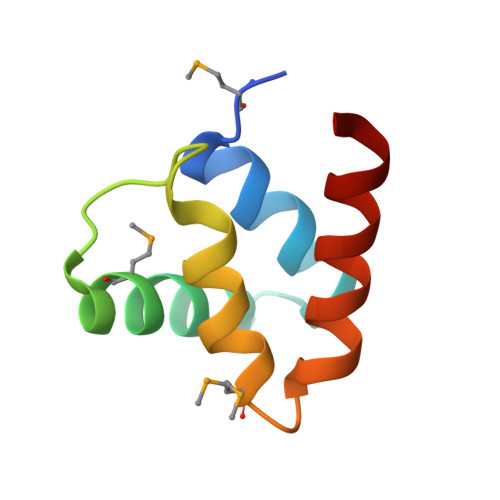Stac-A New Domain Associated with Transmembrane Solute Transport and Two-Component Signal Transduction Systems.
Korycinski, M., Albrecht, R., Ursinus, A., Hartmann, M.D., Coles, M., Martin, J., Dunin-Horkawicz, S., Lupas, A.N.(2015) J Mol Biol 427: 3327
- PubMed: 26321252
- DOI: https://doi.org/10.1016/j.jmb.2015.08.017
- Primary Citation of Related Structures:
5A1Q - PubMed Abstract:
Transmembrane receptors are integral components of sensory pathways in prokaryotes. These receptors share a common dimeric architecture, consisting in its basic form of an N-terminal extracellular sensor, transmembrane helices, and an intracellular effector. As an exception, we have identified an archaeal receptor family--exemplified by Af1503 from Archaeoglobus fulgidus--that is C-terminally shortened, lacking a recognizable effector module. Instead, a HAMP domain forms the sole extension for signal transduction in the cytosol. Here, we examine the gene environment of Af1503-like receptors and find a frequent association with transmembrane transport proteins. Furthermore, we identify and define a closely associated new protein domain family, which we characterize structurally using Af1502 from A. fulgidus. Members of this family are found both as stand-alone proteins and as domains within extant receptors. In general, the latter appear as connectors between the solute carrier 5 (SLC5)-like transmembrane domains and two-component signal transduction (TCST) domains. This is seen, for example, in the histidine kinase CbrA, which is a global regulator of metabolism, virulence, and antibiotic resistance in Pseudomonads. We propose that this newly identified domain family mediates signal transduction in systems regulating transport processes and name it STAC, for SLC and TCST-Associated Component.
Organizational Affiliation:
Department of Protein Evolution, Max Planck Institute for Developmental Biology, D-72076 Tübingen, Germany.
















